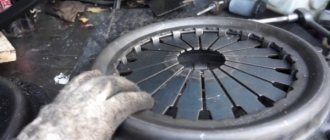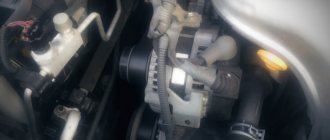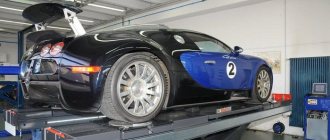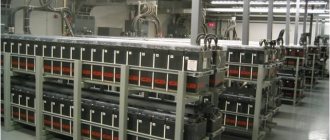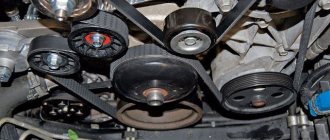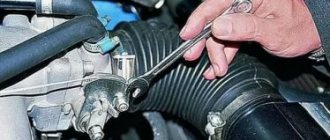Note.
A considerable proportion of attached motor equipment is mounted on the cylinder block, and when the engine is turned on, it works with it as a single unit.
As for the purpose and principle of operation of the piston and other parts of the piston group, we have already discussed this above. Let us only recall that under the force of powerful pressure that is formed in the cylinder after combustion of the working mixture, the piston moves down and transmits its movement through the connecting rod (on which it is installed) to the crankshaft, forming the very torque with which the car is driven into movement.
Know that the internal combustion engine operates in a rather harsh regime. At idle speed (that is, when the engine is running, but the car is stationary in neutral), the crankshaft rotates at a speed of 600-900 revolutions per minute (or about 10-16 revolutions per second). When driving at medium speed, the engine works even more intensely, and the crankshaft rotates at a speed of 2000 to 3000 rpm. And in modern sports cars, the crankshaft rotation speed can exceed 200 revolutions per second (10,000 - 13,000 revolutions per minute).
Consequently, the pistons in the cylinders move up and down very quickly. We have already noted earlier that in one full revolution of the crankshaft, the piston manages to cover the distance between TDC and BDC twice. So: he performs these movements literally in a fraction of a second. If we add to this powerful pressure, as well as high temperature in each cylinder, then the operating conditions of the internal combustion engine can be called extreme.
KShM design
Unlike other car components, the design of the crank mechanism conventionally includes part of the piston group and the crankshaft. The crankshaft consists of moving parts and fixed elements. They have one or more degrees of freedom:
- connecting rod and piston;
- compression, retaining and oil scraper rings;
- piston pin and retaining ring;
- liners, mounting bolt and connecting rod cover;
- flywheel and crankshaft;
- counterweight and connecting rod journals, main ones;
- inserts.
Fixed elements include the cylinder head and block.
Depending on the design of the internal combustion engine and the number of cylinders, the kinematics of the crank mechanism changes slightly:
- in an in-line engine, the plane of the crankshaft and cylinders completely coincide;
- in the VR-shaped motor there is a shift at an angle of 15 degrees;
- in the W-shaped drive, the displacement value reaches 72 degrees.
In other words, in an in-line engine, the working cycle is carried out alternately by 4 cylinders, which allows the load on the crankshaft to be evenly distributed. To achieve compact dimensions, internal combustion engines with a large number of cylinders are placed in a V-shape. This also makes it possible to soften the load on the crankshaft by dissipating part of the energy.
To ensure that the characteristics of the crank mechanism are stable during overloads (high temperature, high pressure and speed, difficulties with lubrication supply), instead of ball/roller bearings, sliding elements with connecting rod and main bearings are used. The unevenness of the angular speeds of the shaft in individual cycles is smoothed out by a massive flywheel due to the inertia of this part.
Operating principle of the crank mechanism
The main task lies with this mechanism, because it converts the reciprocating movement of the piston into rotation of the crankshaft, the shaft from which the useful action is produced.
KShM device
To make it more clear, the engine has a cylinder-piston group consisting of liners and pistons. The top of the sleeve is closed by a head, and a piston is placed inside it. The closed cavity of the liner is the space where the fuel mixture is burned.
During combustion, the volume of the combustible mixture increases significantly, and since the walls of the liner and the head are stationary, the increase in volume affects the only moving element of this circuit - the piston. That is, the piston takes on the pressure of the gases released during combustion and, as a result, moves downward. This is the first stage of transformation - combustion led to the movement of the piston, that is, the chemical process turned into a mechanical one.
And then the crank mechanism comes into action. The piston is connected to the crankshaft via a connecting rod. This connection is rigid, but movable. The piston itself is fixed to the connecting rod by means of a pin, which allows the connecting rod to easily change its position relative to the piston.
The connecting rod with its lower part covers the crank neck, which has a cylindrical shape. This allows you to change the angle between the piston and the connecting rod, as well as the connecting rod and the crankshaft, but the connecting rod cannot move sideways. It only changes its angle relative to the piston, but it rotates on the crank journal.
Since the connection is rigid, the distance between the crank journal and the piston itself does not change. But the crank has a U-shape, therefore, relative to the axis of the crankshaft on which this crank is located, the distance between the piston and the shaft itself changes.
Through the use of cranks, it was possible to organize the conversion of piston movement into shaft rotation.
But this is a diagram of the interaction of only the cylinder-piston group with the crank mechanism.
In reality, everything is much more complicated, because there are interactions between the elements of these components, and mechanical ones, which means that friction will arise at the points of contact of these elements, which must be reduced as much as possible. It should also be taken into account that one crank is unable to interact with a large number of connecting rods, and in fact engines are created with a large number of cylinders - up to 16. At the same time, it is also necessary to ensure the transmission of rotational motion further. Therefore, let’s look at what the cylinder-piston group (CPG) and the crank mechanism (CPM) consist of.
Let's start with the CPG. The main components of it are liners and pistons. This also includes finger rings.
Determination of knocking in the engine.The simplest and most accessible way to diagnose the condition of the crank mechanism is to determine knocking noises in the engine using a stethoscope. Work is carried out on a warm engine at a coolant temperature of 75... 80 °C. Sound amplification in the stethoscope occurs when the membrane vibrates or with the help of a specially built-in transistor amplifier, which is found in the Ekranas stethoscope mod. KI-1154.
When checking the crankshaft bearings, the stethoscope rod is placed against the side wall of the engine block at the location of the main bearings or at the level of the connecting rod bearings when the piston is at TDC. Knocks are heard when the engine is warm when there is a sudden change in the crankshaft speed.
The knocking sound of the main bearings of the crankshaft is strong, the sound is dull, low-pitched, and is heard when the crankshaft rotation speed quickly changes at idle, which is achieved by a sharp increase or decrease in the fuel supply, as well as under load. A knock appears at a gap of 0.1 ... 0.2 mm. With large clearances in the bearings, knocking noise is heard even at a constant crankshaft speed. When one injector (for a diesel engine) or one or two spark plugs (for carburetor engines) is turned off, the nature of the knocks remains almost unchanged.
The knocking sound of the connecting rod bearings of the crankshaft is strong, the sound is sharper than that of the main bearings, and is heard when there is a sharp change in the crankshaft speed or under load. When the injector (for diesel) or the spark plug (for carburetor engines) is turned off in the cylinder, in the lower head of the connecting rod of which there is an increased gap, the knock decreases or disappears altogether. In this way, the increased clearance in a particular connecting rod bearing can be determined.
Knocks at the piston pin-connecting rod interface (appear at a gap of 0.1 mm) have ringing metallic sounds that are heard when there is a sharp change in the crankshaft rotation speed. When you turn off the injector (for diesel) or the spark plug (for carburetor engines), the knocking noise in this cylinder disappears.
Similar knocking noises can also occur with a small fuel injection advance angle (for a diesel engine) or with detonation combustion at an early ignition angle (for carburetor engines). When setting the fuel injection advance (for a diesel engine) or the normal ignition timing (for carburetor engines), these knocks disappear. This does not occur with increased piston pin clearance in the upper end of the connecting rod or in the piston bosses. These knocking noises also disappear when the engine load is reduced.
The knock of the pistons on the cylinder, which appears at a gap of 0.3 ... 0.4 mm, has a dull, clicking sound, which can be heard on a cold engine with a sharp decrease in the crankshaft speed and at low speed.
Determination of knocks in the gas distribution mechanism.
At the gas distribution mechanism, only knocks in the valves are checked. Knocks in the valves of the gas distribution mechanism are heard at any crankshaft speed (especially at low speed) under the cylinder head cover. A strong knocking sound in a warm engine indicates increased clearances between the valve stem and the rocker arm. The sound of a broken valve spring can be heard at any crankshaft speed and does not change in sound.
The noise of the timing gears is heard at low crankshaft speeds in the area of the gear covers. High noise levels indicate gear wear.
Determination of the total gap in the crank mechanism.
Installation of mod. KI-13907 (Fig. 7.1), created by GosNITI, is used to measure gaps in the crank mechanism with mod. KI-11140 and KI-13933M. Installing KI-13907 with the KI-11140 device allows you to measure the total clearance in the upper and lower connecting rod heads when the engine is not running without removing the oil pan. The principle of measuring gaps in these joints is based on measuring the movement of the piston
Rice. 7.1. Connection diagram of the KI-13907 compressor-vacuum unit to the engine:
1 - tip; 2, 4
And
15 -
Accordingly, distribution, discharge and suction pipelines;
3 -
Distribution valve;
5 -
Vacuum gauge;
6, 7 -
Cranes;
8 -
Pressure regulator;
9 -
Safety valve;
10 -
Air cylinder under pressure;
/1 - compressor; 12 -
Vacuum regulator;
13 -
Vacuum cylinder;
14 -
Valve; —► — direction of movement
Crankcase gases
Use an indicator device to alternately create pressure and vacuum in the above-piston space.
As the piston moves upward (toward TDC), the piston pin is pressed against the bottom of the connecting rod's upper head, and the crank (crankpin) is pressed against the top of the connecting rod's lower head. When the piston moves downwards (towards BDC), the points of contact of the indicated parts change to the opposite, i.e. in both cases the indicator will measure the total gap. The upward movement of the piston in the cylinder occurs under vacuum in the space above the piston, and downward movement occurs under air pressure supplied through the nozzle hole from the compressor-vacuum unit.
The compressor-vacuum installation consists of an electric motor and two cylinders, in one of which a vacuum is created, and in the other - pressure. On a pressurized air cylinder 10
There is an oil and moisture separator with a safety valve 9, on a vacuum cylinder
13
there is a vacuum pressure regulator
12
with a pressure gauge, a control valve with a vacuum gauge 5 and an air filter, a pressure reducing valve and an electric starter.
On the body of the vacuum cylinder there may be a valve 14
with a fitting for connecting the device mod. KI-4887-I. The cylinders are connected
With the cylinders of the engine being tested using a flexible hose through the control valve. Compressor 11
It is driven by an electric motor and creates pressure or vacuum.
Device KI-11140
(Fig. 7.2) has a housing
2 with
dial
1 attached to it 39
Replaceable flange
4
for attaching the device to the cylinder head instead of an injector, a seal 5, a guide
6,
a rod 7 rigidly connected to the indicator leg, and a locking screw
8,
Designed to fix the guide in the pneumatic receiver.
To diagnose connecting rod connections in the engine using mod. KI-13907 and devices mod. KI-11140 it is necessary to warm up the engine and after stopping it, remove all injectors. Then set the piston of the first cylinder to the TDC position and fix it so that when compressed air enters the cylinder, the crankshaft does not rotate. The crankshaft can be locked by engaging a gear in the gearbox. Install device mod. KI-11140 with an indicator, after loosening the locking screw and lifting the guide with the indicator and the rod up. Then lower the guide until the rod stops at the bottom of the piston (with interference) and secure it with a locking screw.
Connect the distribution hose of the compressor-vacuum unit mod. KI-13907 to the pneumatic receiver fitting. Turn on the compressor-vacuum unit and set the pressure and vacuum in its cylinders to 0.06 ... 0.10 MPa and 0.06 ... 0.07 MPa, respectively. Connect the vacuum cylinder to the above-piston space and record the indicator reading. The total permissible clearance of the connecting rod heads should not exceed 0.25... 0.30 mm. If the total clearance of at least one connecting rod exceeds the permissible value, it is necessary to repair the engine.
Rice. 7.2. Device KI-11140 for measuring gaps in the crank mechanism
1 — indicator; 2 —
Frame;
3 -
Pneumatic receiver;
4 -
Replaceable flange;
5 - seal; 6 -
Guide;
7 — rod; 8 -
Locking screw
Determining the amount of gases breaking into the crankcase.
Manometric gas flow meter mod. KI-4887-I (Fig. 7.3, i), connected to the cavity of the engine crankcase, measures the amount of gases breaking into the crankcase when the engine is operating in load mode and at ambient air pressure in the crankcase. Ambient air pressure in the crankcase is created by connecting the device to a vacuum installation or to the exhaust pipe (muffler) of a running engine that is being diagnosed. By changing the flow area of the equalizer valve, the required pressure is established and the amount of gases breaking into the engine crankcase is measured.
Throttling hole 72 (Fig. 7.3, B)
It is formed by movable 77 and fixed
10
Bushings.
Bushing 77 has a scale of 16
and can be rotated relative to the fixed bushing. The tight connection of these bushings is ensured by their preliminary joint grinding along the conical surfaces and constant pressing against each other by spacer spring 77. Halfway
Rice. 7.3. Manometric gas flow meter mod. KI-4887-I:
A -
General form;
B -
Scheme of work;
1 -
Cork;
2 -
Channels;
3 -
Housing;
4 —
Throttle limb;
5 and 7 - pressure equalization and suction hoses, respectively; 6 VI 14 -
Inlet and outlet pipelines, respectively;
8 -
Throttle;
9 —
Bracket;
10
AND
11 -
Respectively fixed and movable bushings;
12
AND
15 -
Respectively throttling and calibrated holes;
13 -
Damper;
16 -
Scale of the movable bushing;
17 -
Spring;
18 -
Outlet;
19—
Liquid pressure gauges; —► — direction of gas movement
There are transverse slots around the circumference of the conical part of each bushing, allowing the area of the throttling holes to be smoothly changed when the movable bushing is rotated.
The amount of gases passing through the device per minute is determined by a scale printed on the movable sleeve. The number determining the amount of gases is set against the marks on the body of the device. The instrument scale is calibrated at a pressure difference in the throttling hole equal to 150 Pa. A pressure difference of 150 Pa is set by changing the area of the throttling hole and is controlled by changing the liquid level in the rightmost and middle channels (in the latter the level should be higher). In this case, the liquid level in the outer channels of the device must be the same, which is achieved by turning the valve of the pressure equalizer valve.
Limits for measuring gas flow with the device mod. KI-4887-I with the throttling hole open 2... 120 l/min with an error of up to 3%. If the gas flow exceeds 120 l/min, which happens with worn-out engines, then the throttling hole can be increased to a size corresponding to an increase in gas flow by 40...45 l/min. This is achieved by completely opening the hole 18
When turning the damper
13
Using a screwdriver.
The actual capacity of the hole 18
for each device is indicated on the outer surface of the movable sleeve. There are rubber conical nozzles at the ends of the inlet and suction hoses. To diagnose the cylinder-piston group with the device mod. KI-4887-I you must do the following.
1. Disconnect the engine crankcase ventilation system and close the valve cover and oil dipstick holes with caps or plugs so that crankcase gases can only escape through the oil filler neck.
2. Connect the suction hose of the device mod. KI-4887-I for vacuum pump installation mod. KI-13907 or engine exhaust tract.
3. Start the engine, warm it up and, using the KI-8930 stand, create an operating mode corresponding to full load.
4. Open the throttling hole completely by turning the movable sleeve and the exhaust pipe throttle by turning the device damper mod. KI-4887-I.
5. Determine crankcase gas consumption. To do this, insert the conical tip of the inlet pipe of the device into the hole in the oil filler neck and measure the flow rate of crankcase gases with suction. At the same time, holding the device in a vertical position, turn the valve to set the same level of liquid in the left and right channels. Then, rotating the movable bushing by hand and observing the liquid level in the middle and right channels, close the throttling hole until the transfer is established.
Pressure drop 150 Pa. Possible changes in liquid levels in the middle and left channels are eliminated by turning the valve. Using the divisions marked on the liquid columns of the device, strictly ensure that at the time of measurement the liquid level in the middle column is 15 mm higher than the liquid level in the right column, and the liquid levels in the left and right columns are the same. Using the scale of the movable bushing, determine the crankcase gas flow. Measurements must be carried out 3 times, performing operations 3 - 5.
6. Connect the engine crankcase ventilation system.
7. Measure the amount of gases leaving the crankcase, repeating steps 4 and 5.
8. Determine the amount of gases exhausted through the crankcase ventilation system from the difference in values found during operations 5 and 7.
9. Stop the engine.
10. Determine the condition of the cylinder-piston group and the engine crankcase ventilation system.
11. Disconnect the engine crankcase ventilation system and close the hole with a plug.
12. Measure the amount of gases leaving the crankcase when the engine is running on three cylinders, performing steps 3 - 5.
13. Stop the engine and connect the crankcase ventilation system.
14. Disconnect the device mod. KI-4887-I from the engine.
15. Based on the difference in the average values determined during operations 5 and 12, determine the amount of gases breaking into the crankcase for one cylinder.
16. Determine the state of the cylinder-piston group of the idle cylinder.
Checking compression in the cylinders of a carburetor engine.
As the piston rings and cylinder walls wear out, the compression pressure in the cylinders of a carburetor engine (compression) decreases.
The normal compression value in the cylinders of a heated carburetor engine should be at least 0.7 MPa. A reduction in compression during engine operation is allowed up to 0.63 MPa. The difference in compression gauge readings for individual cylinders should be no more than 0.07...0.10 MPa. Compression is checked on a warm engine.
To check compression you need to:
• clean the dirt collected in the spark plug recess, disconnect the electrical wires from the spark plugs and remove all spark plugs;
• disconnect the central distributor wire from the ignition coil;
• open the air and throttle valves of the carburetor completely;
• insert the rubber tip of the compression gauge hose into the hole in the cylinder spark plug and press it tightly;
• crank the engine crankshaft with the starter, making several revolutions so that the compression gauge records the maximum pressure in the cylinder;
• remove the tip of the compression gauge from the spark plug hole, record the readings;
• open the exhaust valve of the compression gauge and release air;
• repeat the above operations for the remaining cylinders.
If the pressure difference is more than 0.07...0.10 MPa, 20...25 cm3 of fresh oil should be poured into the cylinder with reduced compression and the pressure should be re-measured. An increase in the compression gauge readings indicates the presence of an air leak through the piston rings. If the compression value remains the same after pouring oil into the cylinder, this indicates a loose fit of the valves to the seats or their burnout.
How does the crank mechanism work?
Picture: https://mediaport.net.ua
The mechanism consists of parts, both moving and stationary.
Movable type parts:
- piston;
- oil scraper ring (1);
- compression rings (2);
- piston pin (3);
- retaining ring (4);
- connecting rod;
- connecting rod cover (5);
- mounting bolt (6);
- inserts (7);
- bushing (8);
- crankshaft;
- crankpin (9);
- counterweight (10);
- molar neck (11);
- flywheel
Fixed type parts:
- cylinder block and head;
